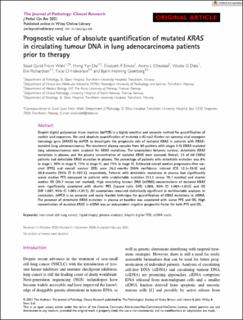| dc.contributor.author | Wahl, Sissel Gyrid Freim | |
| dc.contributor.author | Hong, Yan Dai | |
| dc.contributor.author | Emdal, Elisabeth Fritzke | |
| dc.contributor.author | Ottestad, Anine Larsen | |
| dc.contributor.author | Dale, Vibeke Grotnes | |
| dc.contributor.author | Richardsen, Elin | |
| dc.contributor.author | Halvorsen, Tarje Onsøien | |
| dc.contributor.author | Grønberg, Bjørn Henning | |
| dc.date.accessioned | 2021-03-22T12:55:36Z | |
| dc.date.available | 2021-03-22T12:55:36Z | |
| dc.date.created | 2021-02-22T17:14:52Z | |
| dc.date.issued | 2021 | |
| dc.identifier.issn | 2056-4538 | |
| dc.identifier.uri | https://hdl.handle.net/11250/2734852 | |
| dc.description.abstract | Droplet digital polymerase chain reaction (ddPCR) is a highly sensitive and accurate method for quantication of nucleic acid sequences. We used absolute quantication of mutated v-Ki-ras2 Kirsten rat sarcoma viral oncogene homology gene (KRAS) by ddPCR to investigate the prognostic role of mutated KRAS in patients with KRAS-mutated lung adenocarcinomas. Pre-treatment plasma samples from 60 patients with stages I–IV KRAS-mutated lung adenocarcinomas were analysed for KRAS mutations. The associations between survival, detectable KRAS mutations in plasma, and the plasma concentration of mutated KRAS were assessed. Overall, 23 of 60 (38%)patients had detectable KRAS mutation in plasma. The percentage of patients with detectable mutation was 8%in stage I, 30% in stage II, 71% in stage III, and 73% in stage IV. Estimated overall median progression-free survival (PFS) and overall survival (OS) were 26.2 months [95% condence interval (CI) 12.5–39.9] and50.8 months (95% CI 0–107.3), respectively. Patients with detectable mutations in plasma had signicantlyworse median PFS compared to patients with undetectable mutation (13.1 versus 70.1 months) and shorter median OS (20.7 versus not reached). High circulating tumour DNA (ctDNA) concentrations of mutated KRAS were signicantly associated with shorter PFS [hazard ratio (HR) 1.008, 95% CI 1.004–1.012] and OS(HR 1.007, 95% CI 1.003–1.011). All associations remained statistically signicant in multivariable analyses. Inconclusion, ddPCR is an accurate and easily feasible technique for quantication of KRAS mutations in ctDNA.The presence of detectable KRAS mutation in plasma at baseline was associated with worse PFS and OS. High concentration of mutated KRAS in ctDNA was an independent negative prognostic factor for both PFS and OS. | en_US |
| dc.language.iso | eng | en_US |
| dc.publisher | Wiley Online Library | en_US |
| dc.rights | Navngivelse 4.0 Internasjonal | * |
| dc.rights.uri | http://creativecommons.org/licenses/by/4.0/deed.no | * |
| dc.title | Prognostic value of absolute quantification of mutated KRAS in circulating tumour DNA in lung adenocarcinoma patients prior to therapy | en_US |
| dc.type | Peer reviewed | en_US |
| dc.type | Journal article | en_US |
| dc.description.version | publishedVersion | en_US |
| dc.source.journal | The journal of pathology. Clinical research | en_US |
| dc.identifier.doi | 10.1002/cjp2.200 | |
| dc.identifier.cristin | 1892506 | |
| dc.description.localcode | © 2021 The Authors. The Journal of Pathology: Clinical Research published by The Pathological Society of Great Britain and Ireland & John Wiley & Sons, Ltd. This is an open access article under the terms of the Creative Commons Attribution-NonCommercial-NoDerivs License, which permits use and distribution in any medium, provided the original work is properly cited, the use is non-commercial and no modifications or adaptations are made. | en_US |
| cristin.ispublished | true | |
| cristin.fulltext | original | |
| cristin.qualitycode | 1 | |

